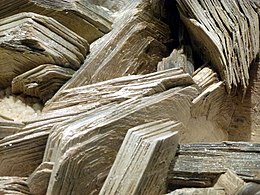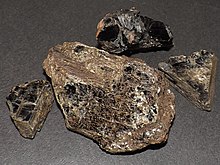
Back ميكا (معدن) Arabic Mica AST Mikalar Azerbaijani Слюды Byelorussian Лушчак BE-X-OLD Слюди Bulgarian অভ্র Bengali/Bangla Mica Catalan Óova'e CHY Slída Czech
| Mica | |
|---|---|
 | |
| General | |
| Category | Phyllosilicates |
| Formula (repeating unit) | AB2–3(X, Si)4O10(O, F, OH)2 |
| IMA symbol | Mca[1] |
| Identification | |
| Color | purple, rosy, silver, gray (lepidolite); dark green, brown, black (biotite); yellowish-brown, green-white (phlogopite); colorless, transparent (muscovite) |
| Cleavage | Almost perfect |
| Fracture | flaky |
| Mohs scale hardness | 2.5–4 (lepidolite); 2.5–3 (biotite); 2.5–3 (phlogopite); 2–2.5 (muscovite) |
| Luster | pearly, vitreous |
| Streak | White, colorless |
| Specific gravity | 2.8–3.0 |
| Diagnostic features | cleavage |
| References | [2][3][4][5] |



Micas (/ˈmaɪkəz/ MY-kəz) are a group of silicate minerals whose outstanding physical characteristic is that individual mica crystals can easily be split into fragile elastic plates. This characteristic is described as perfect basal cleavage. Mica is common in igneous and metamorphic rock and is occasionally found as small flakes in sedimentary rock.[6] It is particularly prominent in many granites, pegmatites, and schists,[7] and "books" (large individual crystals) of mica several feet across have been found in some pegmatites.[8]
Micas are used in products such as drywalls, paints, and fillers, especially in parts for automobiles, roofing, and in electronics. The mineral is used in cosmetics and food[9] to add "shimmer" or "frost".
- ^ Warr, L. N. (2021). "IMA–CNMNC approved mineral symbols". Mineralogical Magazine. 85 (3): 291–320. Bibcode:2021MinM...85..291W. doi:10.1180/mgm.2021.43. S2CID 235729616.
- ^ "Mica". Minerals Education Coalition. Archived from the original on 2015-01-16.
- ^ "The Mica Group". Rocks And Minerals 4 U. Archived from the original on 2015-03-02.
- ^ "Mica". mineralszone.com. Archived from the original on 2015-03-17.
- ^ "Amethyst Galleries – THE MICA GROUP". galleries.com. Archived from the original on 2014-12-30.
- ^ Nesse, William D. (2000). Introduction to mineralogy. New York: Oxford University Press. pp. 244–249. ISBN 9780195106916.
- ^ Nesse 2000, pp. 245–246, 248.
- ^ Jahns, R.H. (1946). "Mica deposits of the Petaca district, Rio Arriba County, New Mexico" (PDF). New Mexico Bureau of Mines and Mineral Resources Bulletin. 25: 60. Retrieved 29 June 2021.
- ^ "CFR – Code of Federal Regulations Title 21". U.S. Food and Drug Administration. July 20, 2022. Retrieved November 1, 2022.